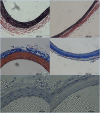Non thermal irreversible electroporation: novel technology for vascular smooth muscle cells ablation
- PMID: 19270746
- PMCID: PMC2650260
- DOI: 10.1371/journal.pone.0004757
Non thermal irreversible electroporation: novel technology for vascular smooth muscle cells ablation
Abstract
Background: Non thermal Irreversible electroporation (NTIRE) is a new tissue ablation method that induces selective damage only to the cell membrane while sparing all other tissue components. Our group has recently showed that NTIRE attenuated neointimal formation in rodent model. The goal of this study was to determine optimal values of NTIRE for vascular smooth muscle cell (VSMC) ablation.
Methods and results: 33 Sprague-Dawley rats were used to compare NTIRE protocols. Each animal had NTIRE applied to its left common carotid artery using a custom-made electrodes. The right carotid artery was used as control. Electric pulses of 100 microseconds were used. Eight IRE protocols were compared: 1-4) 10 pulses at a frequency of 10 Hz with electric fields of 3500, 1750, 875 and 437.5 V/cm and 5-8) 45 and 90 pulses at a frequency of 1 Hz with electric fields of 1750 and 875 V/cm. Animals were euthanized after one week. Histological analysis included VSMC counting and morphometry of 152 sections. Selective slides were stained with elastic Van Gieson and Masson trichrome to evaluate extra-cellular structures. The most efficient protocols were 10 pulses of 3500 V/cm at a frequency of 10 Hz and 90 pulses of 1750 V/cm at a frequency of 1 Hz, with ablation efficiency of 89+/-16% and 94+/-9% respectively. Extra-cellular structures were not damaged and the endothelial layer recovered completely.
Conclusions: NTIRE is a promising, efficient and simple novel technology for VMSC ablation. It enables ablation within seconds without causing damage to extra-cellular structures, thus preserving the arterial scaffold and enabling endothelial regeneration. This study provides scientific information for future anti-restenosis experiments utilizing NTIRE.
Conflict of interest statement
Figures






References
-
- Ward M, Pasterkamp G, Yeung A, Borst C. Arterial Remodeling: Mechanisms and Clinical Implications. Circulation. 2000;102:1186–1191. - PubMed
-
- Davies M, Hagen P. Pathobiology of intimal hyperplasia. Br J Surg. 1994;81:1254–69. - PubMed
-
- Morice M, Serruys P, Sousa J, Fajadet J, Ban Hayashi E, et al. A Randomized Comparison of a Sirolimus-Eluting Stent with a Standard Stent for Coronary Revascularization. N Engl J Med. 2002;346:1773–1780. - PubMed
Publication types
MeSH terms
Grants and funding
LinkOut - more resources
Full Text Sources
Other Literature Sources

